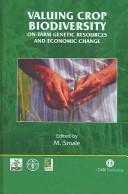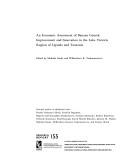| Listing 1 - 10 of 13 | << page >> |
Sort by
|

ISBN: 0851990835 9780851990835 Year: 2006 Publisher: Oxfordshire : CABI Publishing,
Abstract | Keywords | Export | Availability | Bookmark
 Loading...
Loading...Choose an application
- Reference Manager
- EndNote
- RefWorks (Direct export to RefWorks)
Céréale --- Cereals --- Coffea --- Plante légumière --- Vegetable crops --- Musa --- Pomme de terre --- Potatoes --- Oryza --- Plante fruitière --- Fruit crops --- Variété indigène --- Land varieties --- Biodiversité --- Biodiversity --- Germplasm --- Conservation des ressources --- Resource conservation --- Contexte économique --- economic environment --- Politique de soutien --- Support measures --- Mexico --- Hungary --- Ethiopia --- Peru --- Népal --- Nepal --- Uzbekistan --- India --- Italy --- 574.472 --- 633/635 --- 631.526 --- Agronomy. Crop science --- Groups and types of cultivated plants. Genetic resources --- 631.526 Groups and types of cultivated plants. Genetic resources --- 633/635 Agronomy. Crop science --- 574.472 Biodiversity --- Nepal. --- Uganda
Book
Abstract | Keywords | Export | Availability | Bookmark
 Loading...
Loading...Choose an application
- Reference Manager
- EndNote
- RefWorks (Direct export to RefWorks)

ISBN: 9780896291645 Year: 2007 Publisher: Washington International food policy research institute
Abstract | Keywords | Export | Availability | Bookmark
 Loading...
Loading...Choose an application
- Reference Manager
- EndNote
- RefWorks (Direct export to RefWorks)
Book
ISBN: 9780415682985 Year: 2012 Publisher: Abingdon Routledge
Abstract | Keywords | Export | Availability | Bookmark
 Loading...
Loading...Choose an application
- Reference Manager
- EndNote
- RefWorks (Direct export to RefWorks)
Book
Abstract | Keywords | Export | Availability | Bookmark
 Loading...
Loading...Choose an application
- Reference Manager
- EndNote
- RefWorks (Direct export to RefWorks)
Book
Year: 2011 Publisher: Washington, D.C., The World Bank,
Abstract | Keywords | Export | Availability | Bookmark
 Loading...
Loading...Choose an application
- Reference Manager
- EndNote
- RefWorks (Direct export to RefWorks)
There have been numerous episodes of widespread adoption of improved seed and long-term achievements in the development of the maize seed industry in Sub-Saharan Africa. This summary takes a circumspect view of technical change in maize production. Adoption of improved seed has continued to rise gradually, now representing an estimated 44 percent of maize area in Eastern and Southern Africa (outside South Africa), and 60 percent of maize area in West and Central Africa. Use of fertilizer and restorative crop management practices remains relatively low and inefficient. An array of extension models has been tested and a combination of approaches will be needed to reach maize producers in heterogeneous agricultural environments. Yield growth overall has been 1 percent over the past half-century, although this figure masks the high variability in maize yields, as well as improvements in resistance to disease and abiotic pressures that would have caused yield decline in the absence of maize breeding progress. The authors argue that conducive policies are equally, if not more, important for maize productivity in the region than the development of new technology and techniques. Currently popular, voucher-based subsidies can "crowd out" the private sector and could be fiscally unsustainable.
Agricultural Growth --- Agricultural Knowledge & Information Systems --- Agricultural Research --- Agriculture --- Crop Management --- Crops & Crop Management Systems --- Food & Beverage Industry --- Food Security --- Maize Revolutions --- Rural development --- Sub-Saharan Africa
Book
Year: 2011 Publisher: Washington, D.C., The World Bank,
Abstract | Keywords | Export | Availability | Bookmark
 Loading...
Loading...Choose an application
- Reference Manager
- EndNote
- RefWorks (Direct export to RefWorks)
There have been numerous episodes of widespread adoption of improved seed and long-term achievements in the development of the maize seed industry in Sub-Saharan Africa. This summary takes a circumspect view of technical change in maize production. Adoption of improved seed has continued to rise gradually, now representing an estimated 44 percent of maize area in Eastern and Southern Africa (outside South Africa), and 60 percent of maize area in West and Central Africa. Use of fertilizer and restorative crop management practices remains relatively low and inefficient. An array of extension models has been tested and a combination of approaches will be needed to reach maize producers in heterogeneous agricultural environments. Yield growth overall has been 1 percent over the past half-century, although this figure masks the high variability in maize yields, as well as improvements in resistance to disease and abiotic pressures that would have caused yield decline in the absence of maize breeding progress. The authors argue that conducive policies are equally, if not more, important for maize productivity in the region than the development of new technology and techniques. Currently popular, voucher-based subsidies can "crowd out" the private sector and could be fiscally unsustainable.
Agricultural Growth --- Agricultural Knowledge & Information Systems --- Agricultural Research --- Agriculture --- Crop Management --- Crops & Crop Management Systems --- Food & Beverage Industry --- Food Security --- Maize Revolutions --- Rural development --- Sub-Saharan Africa
Book
ISBN: 9290435445 Year: 2002 Publisher: Rome IPGRI
Abstract | Keywords | Export | Availability | Bookmark
 Loading...
Loading...Choose an application
- Reference Manager
- EndNote
- RefWorks (Direct export to RefWorks)
Book
Year: 1996 Publisher: Mexico CIMMYT
Abstract | Keywords | Export | Availability | Bookmark
 Loading...
Loading...Choose an application
- Reference Manager
- EndNote
- RefWorks (Direct export to RefWorks)
Book

ISBN: 9781685851675 1685851673 Year: 2023 Publisher: Boulder
Abstract | Keywords | Export | Availability | Bookmark
 Loading...
Loading...Choose an application
- Reference Manager
- EndNote
- RefWorks (Direct export to RefWorks)
Unless more effective ways can be found to deliver high-yielding seed to farmers in developing countries, the hoped-for “green revolution” in maize production will remain elusive. This comprehensive reference examines the spectrum of technical, economic, and institutional issues that will have to be resolved if maize seed industries are to succeed in reaching greater numbers of those farmers. Ten thematic chapters are followed by nine case studies illustrating the range of developmental paths taken by national maize seed industries—and indicating which institutional arrangements appear to be most effective at fostering rapid and equitable growth in maize production.
| Listing 1 - 10 of 13 | << page >> |
Sort by
|

 Search
Search Feedback
Feedback About UniCat
About UniCat  Help
Help News
News